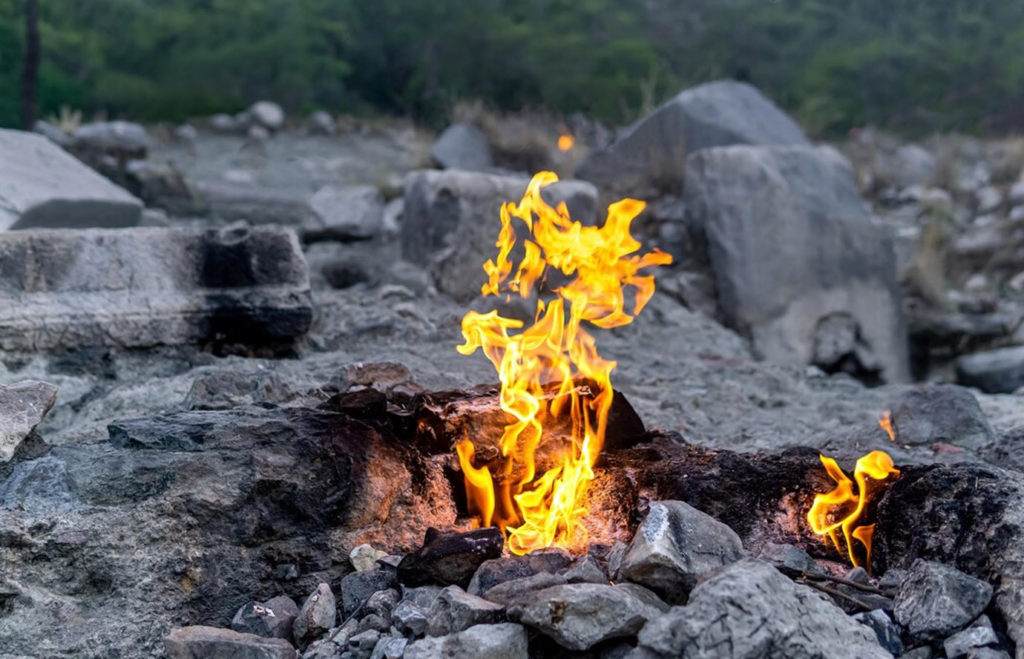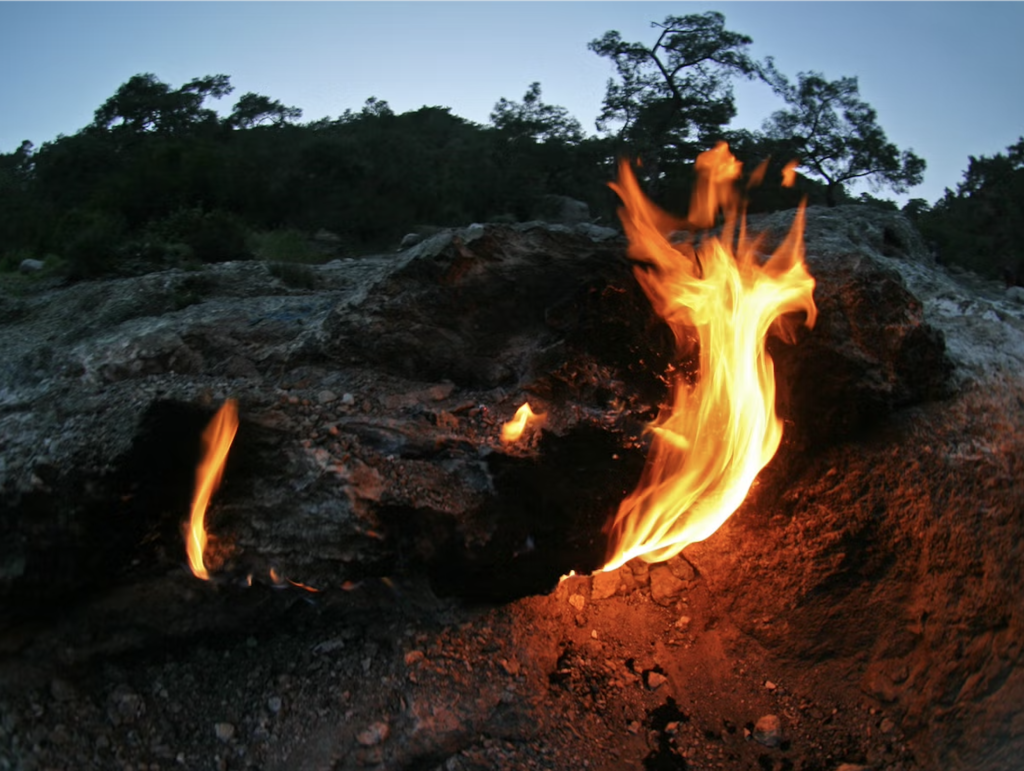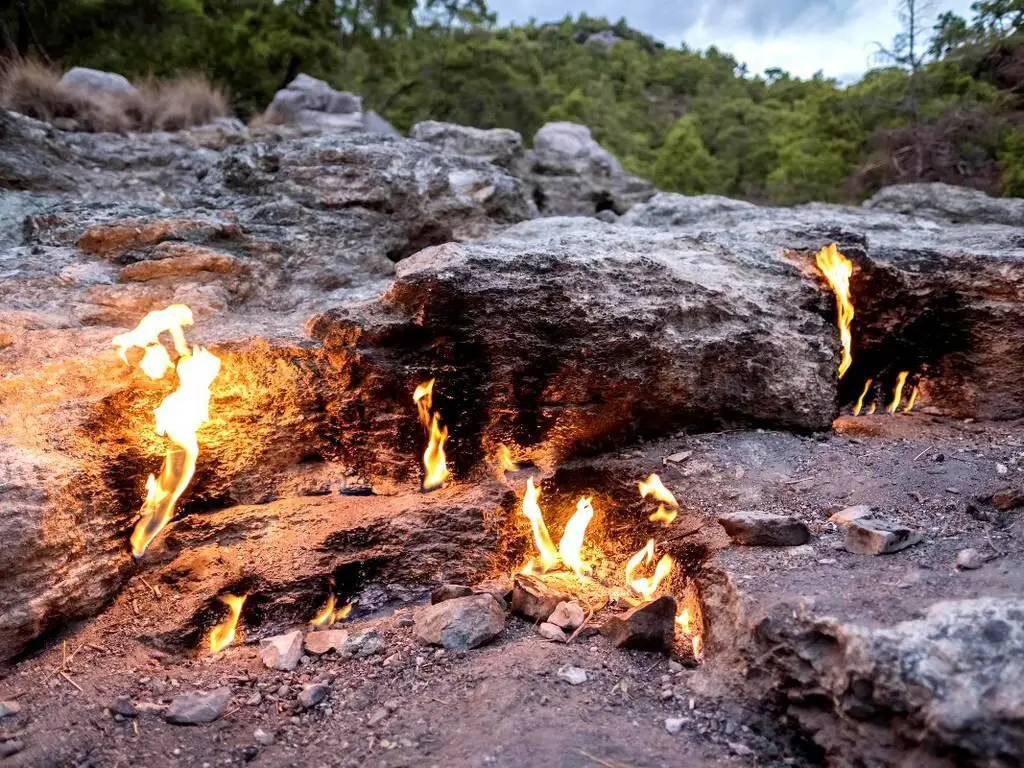In the realm of Greek myth, tales abound with extraordinary creatures and phenomena: winged stallions, minotaurs, and gods with thunderous tempers. Yet, few mythical sites blur the line between legend and reality as convincingly as Mount Chimaera, now known as Yanartaş, in southwestern Türkiye. This ancient and intriguing destination has captured imaginations for millennia, thanks to the eternal flames that erupt from its rocky slopes—a feature so awe-inspiring that even skeptical ancient writers had to admit it defied explanation.
“There is a great opening in the earth, from which fire emerges,” noted the ancient writer Palaephatus in On Incredible Things. “The name of this mountain is Chimaera.” His observations were not myth but reality, for Yanartaş is as mesmerizing today as it was centuries ago, its flames burning perpetually as they did during ancient times. This unique site, nestled in the Olympos Beydagları National Park near Antalya, is an enchanting intersection of natural wonder, ancient history, and mythic imagination.
The Wonders of Yanartaş
Olympos Beydagları National Park, where Yanartaş resides, is a region marked by rugged peaks, crystal-clear coves, and Mediterranean forests. Yet even amid this splendor, the flames of Yanartaş stand out as a marvel. Visitors reach the site by hiking a short trail through fragrant pine woods, ascending to a rocky plateau where flames flicker from small openings in the ground. The smell of faint natural gas mixes with the hum of cicadas, enhancing the otherworldly feel of the place.


This natural phenomenon is caused by methane gas that rises through the earth’s crust and combusts on contact with the atmosphere, producing an eerie, perpetual fire. Beneath the surface, igneous rocks rich in ruthenium create a catalytic environment that perpetuates the methane’s formation, giving Yanartaş one of the world’s most consistently combustible landscapes.
“It’s like nothing else,” says Ibrahim Genc, a Turkish tour guide of over 25 years who regularly leads visitors to Yanartaş. “The flames are so steady that I joked we could cook kebabs here, though, of course, grilling is prohibited.” Beyond its scientific intrigue, the place holds a mesmerizing beauty: the flames burn more vividly in the evening, casting an ethereal glow against the backdrop of distant turquoise seas.


The Myth of the Chimaera: Fact or Fiction?
To ancient eyes, these fires must have appeared nothing short of miraculous. Indeed, the mountain’s mythological ties run deep. Greek mythology speaks of the Chimaera, a fire-breathing beast that terrorized the region of Lycia, thought to be inspired by the fiery landscape of Yanartaş. As depicted by the ancient poet Hesiod, the Chimaera was a formidable creature: “In her forepart, she was a lion; in her hinderpart, a dragon; and in her middle, a goat, breathing forth a fearful blast of blazing fire.”
The Chimaera myth speaks of a hero, Bellerophon, who, riding the winged horse Pegasus, was tasked with slaying the fire-breathing beast by the Lycian King Iobates. According to Homer’s Iliad, Bellerophon, guided by the gods, triumphed, vanquishing the creature. Yet it is likely that “slaying the Chimaera” was a metaphor: in reality, Bellerophon’s victory may have symbolized the human conquest of the flaming mountainside, taming it so that people could dwell safely near its flames.
Later scholars, including medieval writer Isidore of Seville, noted that Bellerophon’s defeat of the Chimaera might have meant he made the mountain livable, lending credibility to the idea that the mountain itself—not a monster—was the real origin of the fiery legend.
Practical Tips for Visiting Yanartaş
Yanartaş is a year-round marvel, but local guide Ibrahim Genc recommends planning a visit from mid-September to late November or mid-March to late May, when the temperatures are cooler. Evening visits, in particular, offer a special experience as twilight accentuates the flames, casting an enchanting glow over the surroundings.
Though tempting, any attempt to use the flames for cooking is discouraged—the site is under state protection, and it is illegal to disturb the flames or the surrounding rocks. Yanartaş and the surrounding areas represent Türkiye’s invaluable natural and cultural heritage, safeguarded for future generations to appreciate.
Türkiye’s Yanartaş remains a testament to the resilience of ancient legends, where the physical world and the mythic intertwine. Visitors to this “burning mountain” experience firsthand the marvel that once inspired tales of fire-breathing beasts and heroic conquests. In Yanartaş, the line between legend and nature blurs, reminding us of the mysteries and wonders that have shaped human culture since antiquity.
Source: CNN Newssource








